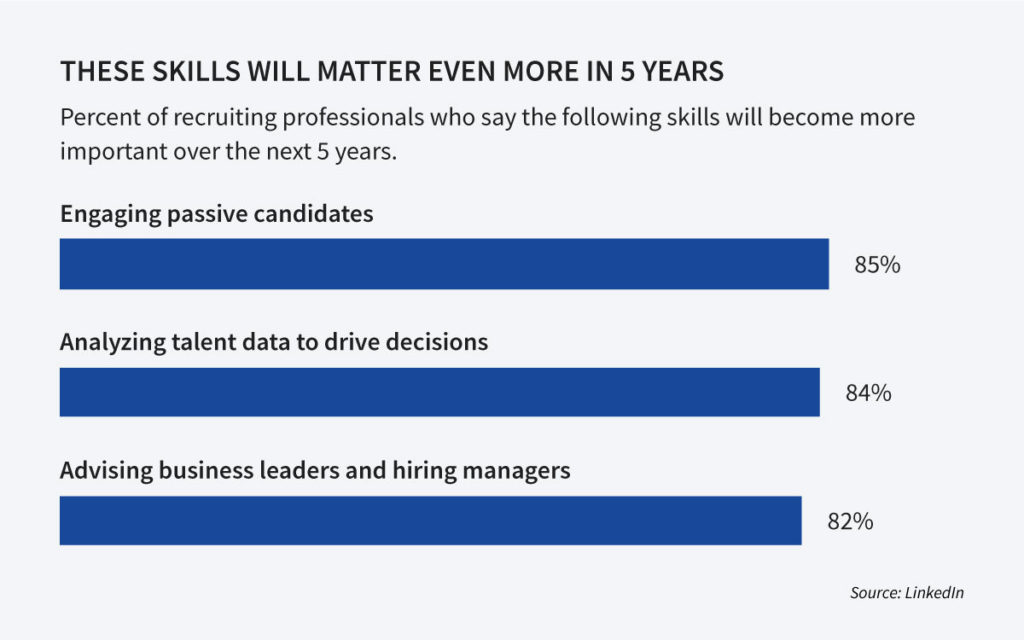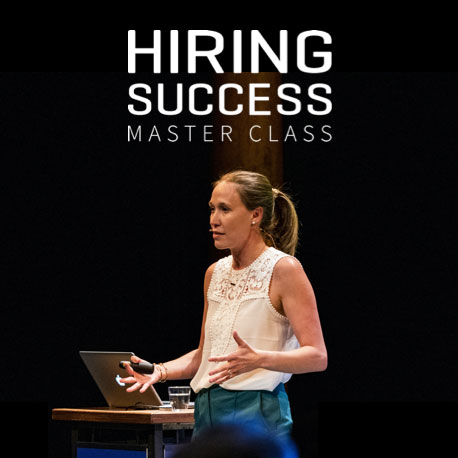More and more, successful companies are investing in talent intelligence teams that are helping them win the war for talent. The time is now for recruiting teams to move from order takers to change makers by leveraging the power of talent and competitive data.
It’s no secret that AI has been and will continue to influence the recruiting technology landscape. Yet, while AI has helped automate many core recruiting tasks, the war for talent has become harder, more complex and more expensive. Navigating this sea change will require both recruiters and recruiting leaders to develop new skill sets and add more company value beyond hiring.
According to a recent study by LinkedIn, 84% of recruiting professionals believe that analyzing talent data to drive decisions will be one of the key skill sets in the next 5 years.

Forward thinking talent leaders are looking for ways to increase their function’s contribution to the company. One key competitive advantage that is being embraced by some of the most successful companies in the world— including Google, Intel, Facebook and Microsoft— are talent intelligence teams.
Talent intelligence as a strategic advantage
Let’s explore how talent intelligence teams add value, how to identify and hire the right people for your team and support their success with the right tools.
Primarily sitting in TA, these are strategic teams that help companies in three core ways: creating talent driven location strategies, understanding competitor footprints, and identifying new and emerging talent threats.
Location strategy is one of the core areas in which talent intelligence teams can add value. While often times recruiting is brought in to hire talent for a new location after it has been decided, a talent intelligence team ensures that TA has a seat at the table before a location is decided or debated. By supporting location work with actual data on talent market availability. These teams help companies make better location decisions by analyzing whether the talent they need to hire even exists in the markets that executives may be interested to expand into.
Some of the most compelling examples of adding value through location analysis are related to diversity. Simply by combining availability of key talent pools by geography with publicly available census data, companies are able to prioritize which locations are more likely to help them meet their diversity hiring goals.

Similarly, talent intelligence teams can often add significant value by mapping out the talent footprint of all of your competitors. By understanding which geographies your competitors are hiring in and whether they are hiring for new types of talent to extend to a new market, a talent intelligence team can deliver significant value not only to recruiting, but also with regard to corporate development, mergers and acquisitions, and executive functions, as well. Often times there can be great value in helping your company decide where not to go based on lack of talent availability as well.
Many talent intelligence teams also focus on providing value by mapping and tracking talent flows both with their own company and at those of competitors. Being able to understand that a particular function within your company may be shedding talent to a key competitor, or that you have been over-hiring from a particular company are valuable insights that are often missed by TA teams without talent intelligence.
Further value is also unlocked by connecting the research that talent intelligence teams deliver to the core recruiting work that is done by recruiting and sourcing teams. By moving to a data-based approach that’s supported by actual market data and tracked over time, companies can more effectively source and ultimately hire the right talent at scale.
Getting started
Hiring team members with the right competencies is key to creating a high performing talent intelligence team. While many of the leading companies often employ data analysts or team members with previous consulting experience from top tier companies, you will only need to look for three core skill sets as you build your team.

1) Hire for curiosity
The best talent intelligence team members have a knack for asking “why” a lot and wanting to dig into the story behind the story. Being able to understand the deeper story behind why your competitor opened a new office, posted a mysterious job req in a new area, or suddenly lost many of their best engineers to another competitor will help your company compete more effectively.
2) Cultivate effective storytellers
Talent intelligence team members will often find themselves influencing or presenting to some of the top executives of the companies they work for. As their work is influencing truly strategic decisions that impact millions of dollars worth of spend, hiring people that are able to distill complex topics and multiple data points into a streamlined recommendation is key.
3) Seek people who love data
While talent intelligence team members do not need to be data scientists or specialize in machine learning (ML), they do need to be able to actively collect and interpret data that is used in their analysis. Hiring team members that love excel helps a lot here, as does hiring someone who gets excited at the thought of being able to use a data visualization product like Tableau, PowerBI or Google Data Studio.
Many people that thrive on talent intelligence teams also have backgrounds in executive search, as many of the market mapping and core executive presentation skills overlap.
Setting your team up for success
Almost as important as hiring the right team members and defining the right mission is providing them with the right tools to be successful. Talent intelligence teams can be supported with a wide variety of tools including paid and non-paid.
The first tool that your team will need is access to both internal and external data. For internal data many teams will look to leverage their ATS or HCM systems to understand current hiring trends and attrition hot spots. For external data, there are many systems available among them LinkedIn Talent Insights, EMSI and others. These products provide the ability to get a snapshot of external talent data that the team can then use to create a map of your company’s external talent ecosystem. Other external data sets are virtually limitless but can often include offerings from Google Patent search, Crunchbase, BLS data, university rankings and Glassdoor.

After the team has begun to collect and analyze some of the data streams mentioned above, the next tool they will need is visualization software. Many companies leverage the software of their cloud provider using Google Data Studio for GSuite customers and PowerBI for O365 customers. Being able to visualize the data effectively will help distill the insights from your team to be more easily consumed by leaders and your broader TA organization.
Probably the single most powerful thing that teams looking to develop this capability can do is begin tracking consistent data over time. Even simple things like tracking how many people are leaving your company over time and where they are going paired with the companies you are hiring from can be incredibly valuable and simple to do.
What are you waiting for?
Talent intelligence teams are a distinct competitive advantage and are already helping leading companies win the war for talent proactively. You can help your team today by beginning to identify data that you already have access to for internal and external talent, seeking out internal talent that could thrive in this role and defining a talent intelligence team as a unique and distinct team with TA.
Whether you are looking to create a team with multiple analysts that reports regularly to your executive team or looking to get started with one analyst that supports your recruiting organization, talent intelligence will be a key differentiator in how TA organizations deliver value in the age of AI.

 Enroll in the Master Class & earn 6 SHRM credits
Enroll in the Master Class & earn 6 SHRM credits